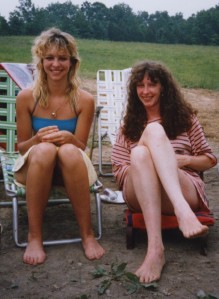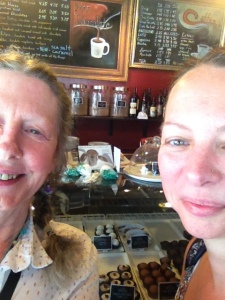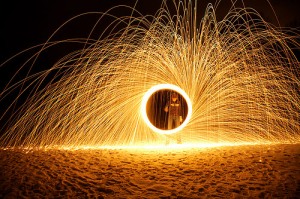
KATE’S READING excerpt with Cathy from the “Honeymoon” Chapter of Kathleen~Cathleen at American Adoption Congress Conference, San Francisco 2014
As we work on finishing our draft of Kathleen~Cathleen, we wanted to do something new on the blog. For the first time on the blog, we are sharing excerpts from the memoir’s original manuscript with you, our readers. We hope to hear your thoughts, impressions and questions.
The intent of our memoir is to share the true story of reunion in all its complexities; the heights of its joys, the depths of its sorrows and the perseverance it takes to journey through the thrill of the initial meeting to get to the grips of a real relationship. There are many stories that share the experience of separation and reunion. Our book explains what happens next.
As we do with the blog, we have written from the unique and contrasting experiences of both the birthmother and the adoptee through our individual viewpoints. The excerpts we are posting here are the only parts of the book that we have shared with each other. While we have an outline that we created together, we have not yet read each other’s chapters. We want to keep the purity of our personal recollections and impressions uninfluenced by the other’s point of view.
The result is that it is you, the reader, who brings the stories together, creating something new, something greater than the sum of its parts.
Over the next few weeks we will share sections from the memoir that highlight crucial turning points in our relationship: Honeymoon, Going Dark, Therapy and Integration.
The excerpt below is taken from Kate’s side of the “Honeymoon” chapter from Kathleen~Cathleen, and Cathy’s first morning in the kitchen after her arrival in Portland (then read Cathy’s Honeymoon excerpt at ReunionEyes.
_ _ _ _ _ _ _ _ _ _ _ _ _ _ _ _ _ _ _ _ _ _ _ _
“Oh, you’re up!” I said as Cathy shuffled into the kitchen.
“Good morning” she said sleepily, eyeing the bathroom door.
“Make yourself at home, Cathy. Coffee will be ready soon. The bathroom’s free if you want it.”
“Thanks. I might take a bath,” she said as she went in and closed the door.
Before long , she was back in the kitchen, now refreshed. She pulled a chair up to the table by the window and told me that Heather had left early that morning to go for a hike with a friend they had met on the Green Tortoise bus.
I filled the kettle with water from the tap, put it on the burner and lit the stove. The paper filter was filled with fragrant, fresh ground coffee. I poured hot water from the kettle and watched it transform into its dark brew. I could feel the motherly urge to nourish Cathy imbue my offering as I gripped the mug carefully and set it on the table in front of her.
She poured a long stream of cream into the mug and I watched it turn from dark brown to nearly white. She stirred several teaspoons of sugar into the milky mix with her spoon.
“I see you like a little coffee with your milk!” I chuckled as she pressed her lips into a smile. I wondered what to say next as we sat at the kitchen table.
“How did you sleep?” I asked.
“Good” she said.
Anxiety and delight shuttled back and forth inside me. We had only clocked in a few hours together. So far, so good.
Today would mark the first full day in this new chapter together. We had no script. I felt exhilarated, terrified – and game.
Cathy’s eyes watched me as she sipped her creamy brew. She had accepted my invitation to come to Portland to try me on for size. I could feel her check me out as I waited for her to speak. My mind was reeling fast, spinning with thoughts that held tight on my tongue, waiting to give her time to answer.
Her thick, collar-length hair was a lush coppery mix of browns and bronze. I asked her about the long skinny braid with a bead at the end; it hung a foot longer than the rest.
“I keep this one strand growing to remind me of where I’ve been,” she replied, and picked up the end to twirl the blue bead between her fingers and her thumb.
I soaked her in as we sipped. My eyes followed the pretty curves of her face like a magnet, coming to rest on the aquamarine glint in her eyes that looked back at me with a frank expression. I couldn’t resist looking at her face. I tried to be subtle, but smiled when I knew she’d caught me gazing – as new mothers do.
She had eyes the color of ocean waves catching light, the same aqua light that is in my younger daughter, Abigail’s eyes – my sister, Mary’s, too.
I returned Cathy’s gaze with my own plain, slate-blue eyes inherited from my mother’s mother on the Scottish side. I shyly reached to touch Cathy’s hair with my fingers.
“Your hair is beautiful,” I whispered.
She let me touch her hair the way a child would, quiet and waiting. My thumb gently rubbed the long tendril across my curled finger, poised to hold the strand of her burnished hair in my hand. Since the first dark fluff on the day she was born, I hadn’t touched her hair. It had been bleached with dark roots when we had first met. She’d been eighteen. Now, her thick mane of nut-brown hair touched her shoulders.
I let go, smiling. She smiled back.
We both have dramatic natural hair. It was a basic trait that was evidence of the truth of her identity. We saw things that we recognized in each other as we sat across the table. I had savored that brief touch of her hair. I hadn’t guessed what her hair would feel like. It was even thicker than mine. I felt akin to her and tears welled under my eyelids. We were related, after all.
It was an odd feeling not to have to hide or pretend anymore. Cathy had freely made her choice to come to me.
I let my arm reach up to touch her hair again. She smiled as I drew in the sensation of its auburn threads with my fingertips, to let my senses take in the essence of this daughter. It reminded me of honeysuckle in bloom – so sweet and never enough to fill the appetite. I let go.
“It’s nice to touch your hair, thank you”. I smiled and looked down at my coffee.
~~~~~~~~~~~~~~~~~~~~~~~~~~~~~~~~~~~~~~~~~~~~~~~
To read my daughter’s counterblog, please visit ReunionEyes.
~~~~~~~~~~~~~~~~~~~~~~~~~~~~~~~~~~~~~~~~~~~~~~~
“Pandora” painting by John William Waterhouse 1896
All Rights Reserved ©2015
 The word “birthmother” triggers shame, sadness, regret and loss in me. It is not a moniker I like. It is the word in our vernacular for mothers who have lost their children to adoption. I have surrendered to its use but experience its usage as a painful burr that continues to rub my wound. It’s implication is demeaning and implies a breeding animal, not a mother. Still, it’s the word people seem to understand without further explanation, so I use it.
The word “birthmother” triggers shame, sadness, regret and loss in me. It is not a moniker I like. It is the word in our vernacular for mothers who have lost their children to adoption. I have surrendered to its use but experience its usage as a painful burr that continues to rub my wound. It’s implication is demeaning and implies a breeding animal, not a mother. Still, it’s the word people seem to understand without further explanation, so I use it.




 Cathy spoke as one of the
Cathy spoke as one of the 
 When I see myself in home movies as a child, I can see my gregarious side. I was in love with life and responded to my surroundings, my many siblings, and the turning wheel of events with a zest filled with positive charge.
When I see myself in home movies as a child, I can see my gregarious side. I was in love with life and responded to my surroundings, my many siblings, and the turning wheel of events with a zest filled with positive charge. One of the only times I ever heard my oldest daughter cry was on the telephone when I told her I was leaving Portland to move north a few years ago. I can still hear her voice tremble on the phone, “But it will mean that I won’t see you and losing you when I was a child just makes it really hard now. I want my kids to know you.” I heard her words and felt the pain inside of me roar back up my spine as I responded from a parking lot hundreds of miles away in my RV parked after a gig in Wallowa County in far eastern Oregon.. “I know. I will miss you, too” and the dull ache of the all too familiar loss took its seat back in my gut. Family needs compelled us to break away from the familiarity of home to try a smaller place near my youngest daughter who was putting herself through college with our granddaughter who was turning six.
One of the only times I ever heard my oldest daughter cry was on the telephone when I told her I was leaving Portland to move north a few years ago. I can still hear her voice tremble on the phone, “But it will mean that I won’t see you and losing you when I was a child just makes it really hard now. I want my kids to know you.” I heard her words and felt the pain inside of me roar back up my spine as I responded from a parking lot hundreds of miles away in my RV parked after a gig in Wallowa County in far eastern Oregon.. “I know. I will miss you, too” and the dull ache of the all too familiar loss took its seat back in my gut. Family needs compelled us to break away from the familiarity of home to try a smaller place near my youngest daughter who was putting herself through college with our granddaughter who was turning six. The affection factor in the large family I grew up in was strong. We were a physical family of ten and as siblings we hugged, held hands, and sweet smiles wove us together in eye-to-eye moments that conveyed understanding and acceptance. We also tussled with each other in the inevitable pecking order of so many kids. It was part of our body language and we were expressive and comfortable with each other. There were times when the family was young when we slept head-to-foot just to fit all of us in the available beds on family outings to visit relatives – and we knew each other as well as a litter of pups making our way between giggles and wriggles into whatever space held us as children growing up together.
The affection factor in the large family I grew up in was strong. We were a physical family of ten and as siblings we hugged, held hands, and sweet smiles wove us together in eye-to-eye moments that conveyed understanding and acceptance. We also tussled with each other in the inevitable pecking order of so many kids. It was part of our body language and we were expressive and comfortable with each other. There were times when the family was young when we slept head-to-foot just to fit all of us in the available beds on family outings to visit relatives – and we knew each other as well as a litter of pups making our way between giggles and wriggles into whatever space held us as children growing up together. The characters portrayed in adoption triads are strong. The birthmother is seen as strong because she has made the counterintuitive decision to go to term and then release ownership of her child to other people. The child is automatically perceived as strong because she is perceived as adaptable from her original family to another, and can co-exist as being “different” from the other members of her new family. The adoptive parents are strong people because they have made a socially admired decision to take care of someone else’s child as if she were their own. The birth family members are also strong because they hold the façade together of continuity in the family when the pre-born has been reassigned to live outside of the family because “it’s better that way.” Strength is confusing.
The characters portrayed in adoption triads are strong. The birthmother is seen as strong because she has made the counterintuitive decision to go to term and then release ownership of her child to other people. The child is automatically perceived as strong because she is perceived as adaptable from her original family to another, and can co-exist as being “different” from the other members of her new family. The adoptive parents are strong people because they have made a socially admired decision to take care of someone else’s child as if she were their own. The birth family members are also strong because they hold the façade together of continuity in the family when the pre-born has been reassigned to live outside of the family because “it’s better that way.” Strength is confusing.